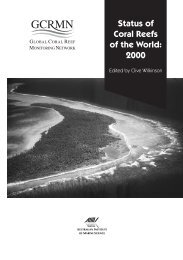MATERIAL DE RECIENTE INGRESO
material de reciente ingreso - Instituto de Ciencias del Mar y ...
material de reciente ingreso - Instituto de Ciencias del Mar y ...
You also want an ePaper? Increase the reach of your titles
YUMPU automatically turns print PDFs into web optimized ePapers that Google loves.
1. The biogeography of invasive alien plants in California: an application of GIS and spatial<br />
regression analysis<br />
Dark S.J.................................................................................................................................... 1-9(9)<br />
2. Introduced plants of the invasive Solidago gigantea (Asteraceae) are larger and grow denser<br />
than conspecifics in the native range<br />
Jakobs G.; Weber E.; Edwards P.J., ..................................................................................... 11-19(9)<br />
3. On the importance of patch attributes, environmental factors and past human impacts as<br />
determinants of perennial plant species richness and diversity in Mediterranean semiarid steppes<br />
Maestre F.T., ........................................................................................................................ 21-29(9)<br />
4. Parasite species richness in New Zealand fishes: a grossly underestimated component of<br />
biodiversity?<br />
Poulin R. .............................................................................................................................. 31-37(7)<br />
5. Modelling spatial patterns of biodiversity for conservation prioritization in North-eastern Mexico<br />
Ortega-Huerta M.A.; Peterson A.T. ..................................................................................... 39-54(16)<br />
6. Rapid assessment in conservation research: a critique of avifaunal assessment techniques<br />
illustrated by Ecuadorian and Madagascan case study data<br />
O'Dea N.; Watson J.E.M.; Whittaker R.J. .............................................................................. 55-63(9)<br />
7. Morphological responses of Leymus chinensis (Poaceae) to the large-scale climatic gradient<br />
along the North-east China Transect (NECT)<br />
Renzhong W.; Qiong G......................................................................................................... 65-73(9)<br />
8. The decline of the sea turtles, ........................................................................................... 75-75(1)<br />
9. High biodiversity: an assessment of mountain biodiversity ................................................ 75-76(2)<br />
10. Biodiversity paying its way............................................................................................... 76-77(2)<br />
11. An updated flora of Egypt ............................................................................................... 77-78(2)<br />
12. Terrestrial orchids of the northern temperate zone .......................................................... 78-78(1)<br />
13. How our planet works?, .................................................................................................. 78-79(2)<br />
14. The flora of Nicaragua .................................................................................................... 79-79(1)<br />
ENVIRONMENTAL GEOLOGY<br />
VOLUME 45, NUMBER 1<br />
<strong>DE</strong>CEMBER 2003<br />
Observation of isotopes in the water cycle—the Swiss National Network (NISOT) .................... 1 - 11<br />
Marc Schürch, Ronald Kozel, Ulrich Schotterer, et al.<br />
Stable lead isotopes reveal a natural source of high lead concentrations to gasoline-contaminated<br />
groundwater ........................................................................................................................... 12 - 22<br />
J. E. Landmeyer, P. M. Bradley, T. D. Bullen<br />
Subsurface movement of zinc from contaminated dredge spoils at a periodically flooded site . 23 - 34<br />
W. R. Kelly, H. A. Wehrmann, T. R. Holm, et al.<br />
Weathering of sulfidic shale and copper mine waste: secondary minerals and metal cycling in<br />
Great Smoky Mountains National Park, Tennessee, and North Carolina, USA ........................ 35 - 57<br />
Jane M. Hammarstrom, Robert R. Seal, Allen L. Meier, et al.<br />
The content of some microelements in mineral waters from Covasna and Harghita Romanian<br />
districts ................................................................................................................................... 58 - 64<br />
Gabriela-Raluca Babaua, Anca-Iulia Stoica, Petre Capota, et al.<br />
Evaluation of aluminum speciation in surface waters in China and its environmental risk<br />
assessment ............................................................................................................................ 65 - 71<br />
S. P. Bi, N. Gan, X. C. Lu, et al.<br />
Ammonium adsorption by tidal flat surface sediments from the Yangtze Estuary ..................... 72 - 78<br />
L. J. Hou, M. Liu, H. Y. Jiang, et al.<br />
The stability of the relative content ratios of Cu, Pb and Zn in soils and sediments .................. 79 - 85<br />
Huan-Xin Weng, Xing-Mao Zhang, Xun-Hong Chen, et al.<br />
Geochemical studies to delineate topsoil contamination around an ash pond of a coal-based<br />
thermal power plant in India .................................................................................................... 86 - 97<br />
T. Praharaj, S. Tripathy, M. A. Powell, et al.<br />
22
















